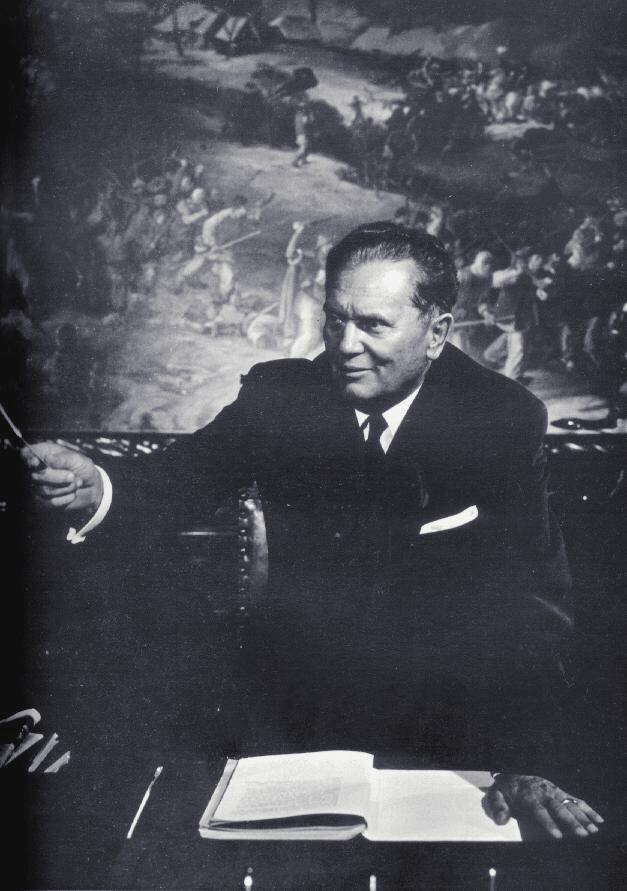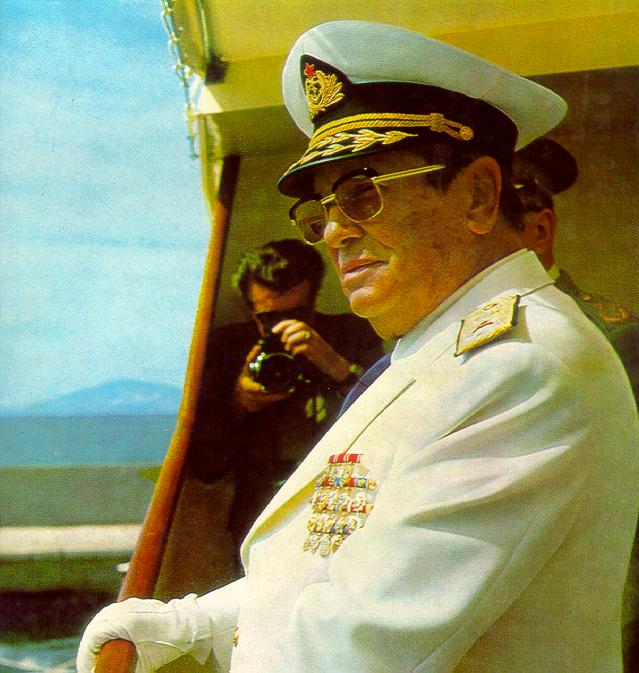"Tito"
Marshal
Josip Broz
Biography|
Links
| Tito Gallery | Return
to Dictators Index
Biography
-
Tito, Josip Broz (1892-1980), president of Yugoslavia, who established
a Communist state independent of the USSR after World War II (1939-1945),
and later became a leader of the Nonaligned Movement.
-
Originally named Josip Broz, he was born in Kumrovec, Croatia of a Slovene
mother and a Croatian peasant father.
-
Tito served as a noncommissioned officer in the Austrian army during World
War I (1914-1918) and after the war he returned to Croatia to work as an
illegal Communist Party organizer. After serving a prison term from 1928
to 1934 and taking the name Tito as an alias, he went to Moscow to work
for the Communist International.
-
In 1936 the Comintern sent Tito back to Yugoslavia to purge the Communist
Party there. In 1937 he became secretary general of the Yugoslav Communist
Party. During this period he faithfully followed Comintern policy, criticizing
Serbian domination of other Yugoslav nationalities and agitating for the
breakup of the Yugoslav state.
-
After Nazi Germany attacked both Yugoslavia and the USSR in 1941, Tito
formed an all Yugoslav Partisan force to resist the Germans and their Croatian
Fascist allies. Tito primarily fought defensive battles against Germany.
In 1942 he formed a Communist-dominated provisional government, which brought
him into conflict with the Cetniks, a Serbian resistance movement
that favored the restoration of the prewar monarchy. After unsuccessful
attempts to reconcile the rival groups, the Allies gave their support to
Tito in 1944. In March 1945 Tito was recognized as prime minister. By the
end of that year the Germans were defeated, and the war torn country was
united, leaving Tito's government in full control. Without holding a referendum
on whether to restore the monarchy or make Yugoslavia a republic, Tito
set up a one party dictatorship.
-
At first Tito was a loyal follower of Joseph Stalin, but when the Soviet
leader criticized some of his actions he rejected Stalin's criticism. Consequently,
the Yugoslav party was expelled from the Cominform in 1948. This extreme
action left Tito with two options: submit to Soviet domination or assert
Yugoslav independence. He chose independence, a decision supported by the
United States, which was in the midst of the Cold War. With his aides,
Edvard Kardelj and Milovan Djilas, Tito revived Marxist humanism,
which included the concept of workers' self management, and recommended
liberal economic reforms. They also decentralized the party and governmental
power. This decentralization led to an emergence of nationalist
tendencies within the republics. In the 1960s Tito joined with leaders
of African and Asian countries, including India and Egypt, to promote the
concept of nonalignment�independence from both the United States and the
USSR. Each country made its own decisions, trying to stay neutral in the
Cold War.
-
In 1952 Tito, a Croat, married his fourth wife, a young Serbian Partisan
aide named Jovanka Budisavljevic, thus symbolically uniting two of the
largest and most antagonistic nationalities of Yugoslavia. The following
year Tito was elected president. A partial reconciliation with the USSR
in 1955 further enhanced Tito's prestige at home and abroad. Nevertheless,
Yugoslavia's independence remained an irritant to the Soviet leaders and
a challenge to their domination over Eastern Europe. Tito supported the
Soviet policy of détente with the West, but protested against the
USSR's invasions of Hungary (1956), Czechoslovakia (1968), and Afghanistan
(1979). His independent stance preceded and influenced the Chinese, Albanian,
and Eurocommunist challenges to Soviet supremacy in the Communist
world. In 1963 Tito relinquished the position of prime minister. He was
named president for life in 1974. Tito died six years later after a prolonged
illness and was buried on the grounds of Tito's Museum in Belgrade.
-
One of the most influential manipulators of postwar power politics, Tito
controlled Yugoslavia for 35 years. In foreign affairs he was a persistent
promoter of détente, global nonalignment for the Third World, and
pluralism within the international Communist movement. At home, he permitted
some liberal reforms, but maintained the Communist Party's monopoly of
power. Tito's policies, however, encouraged separatist and nationalist
tendencies among rival republics, which helped to sow the seeds for bloody
civil war in the 1990s, some ten years after his death
-
1950: The opening of Goli Otok and similar labour/prison camps for political
prisoners.
Tito
Gallery
Links




